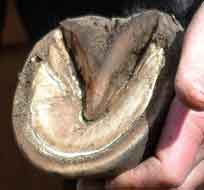What the words mean
Laminitis means inflammation in the laminae -- the interlocking, paper-thin strips that hold the hoof wall onto the coffin bone (also called "P3," referring to "3rd phalanx below the knuckle or fetlock.")
The three most common reasons for laminitis are: insulin resistance, "leaky gut" syndrome, and Cushings syndrome. Other causes are infection or disease anywhere in the horse's body; colic; overeating on grain or other high-sugar foods; eating poisonous plants; and overwork on a hard surface ("road founder").
Laminitis is extremely painful, and will result in loss of the laminar (white line) connection unless the cause is immediately removed. Wild horses treat laminitis by standing in cold water and by moving the usual 20 miles (30 km.) per day with the herd in search of food; within 2 or 3 days it goes away.
Founder means that the coffin bone has dropped away from the
inside of the hoof wall and is pressing down onto the sole corium. There is
extreme pain both in the torn laminae and in the sole corium.
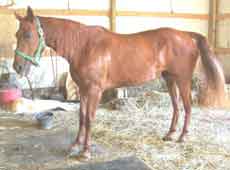 |
Here is a horse in the typical founder stance. She keeps her front feet forward, trying to relieve pain in the toes. Her hind feet are also forward, carrying more than their share of her weight. The hindquarters are overworked and have lost muscle -- she has been foundered for some time. |
Rotation, one type of founder, means that only the toe of
the coffin bone has dropped, thus "rotating" its angle relative to the
short pastern bone (P2). The sharp toe of the coffin bone presses on the
sole corium and can penetrate the sole. You can feel a depression in the
front of the coronet, where the P2-P3 joint is more open than usual. The
rotated coffin bone is still attached to the hoof wall by laminae at the
quarters.
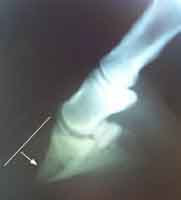 |
Here is an x-ray of a foundered hoof, from the horse shown above. Straight line shows where the front of the coffin bone would normally be. Arrow shows how far the coffin bone has rotated downwards. This is a lot of rotation; in this horse the coffin bone is penetrating the sole. |
Sinking, the other type of founder, means that the entire white line has separated; the coffin bone has settled down onto the entire sole. You will see a channel or trench around the entire coronet, about the right size to roll a marble around the hoof. Because there is no remaining laminar connection, a sunken coffin bone is a lot more difficult to rehabilitate.
Founder can be due laminitis -- the laminae separate because they are inflamed. Or it can be due to constant mechanical forces that pry the hoof wall away from the coffin bone. Mechanical founder is the gradual, silent stretching and separation that we find in many shod horses, or in the overgrown, neglected feet of some "rescue horses."
Flare or flaring means a visible change in the shape of the hoof wall when there is stretching or separation of the laminae, due to either inflammation or mechanical forces. If only the bottom of the wall is flared, it is usually due to the hoof needing a trim; this kind of flare is often curved and easy to see.
A flare due to laminitis or long-term mechanical stress (shoes or an imbalanced trim) often is straight in outline, and may be difficult to recognize. The angle of the wall changes abruptly, high up -- sometimes so close to the coronet that you can't see where it changes.
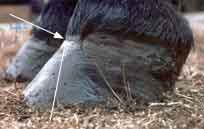 |
This is a founder flare. The toe appears straight, but there is a bend in the toe angle just below the hairline (arrow). Line shows approximate rotation of the coffin bone. The heel has also gotten very long, typical in a chronic founder. |
Flare tells us that white line stretching or separation has occurred; flare and white line separation are the same thing. A founder is a flare that has gone so far that the coffin bone has rotated.
Begin with a different point of view
In recent times, founder is considered a disaster. Before, you would pull the shoes and turn the horse out to pasture for a year; put him back to work when he was sound again; and life went on.
Founder has gotten to be a "big, scary deal" because conventional medicine has gotten very high-tech and ignored the horse's own excellent healing process. The horse doesn't need "orthopedic" shoes; he doesn't need fancy drugs that confuse his system and overload his liver; and he especially doesn't need "stall rest."
Horses are good healers. The horse can recover from founder just fine with bare feet, a wild-horse trim using the "white line strategy" as shown on this website, and lots of moving around. The more we interfere, using high-tech treatments, the harder it is for him to do his healing process.
Therefore:
- -- pull the shoes
-- provide 24-hour turnout, preferably with another horse(s) so there is motivation to move around more
-- feed grass hay (no alfalfa), available 24 hours; soak the hay before feeding if it's high in sugars
-- in trimming, the priority for the horse's immediate comfort is to remove flares.
A Trim for Rehabilitating Founder
There is a typical foundered look. The toe may be strongly flared ("slipper toe" or "duckbill"); the white line (laminae) is extremely stretched and is soft like rotten wood. The sole is flat where the coffin bone presses down onto it, so that the hoof "looks like a block of wood." The hairline and the lateral cartilages may bulge upwards. In a chronic situation the heels get very long, due to crushing of the toe growth at the coronet.
The barefoot approach is to grow a new hoof capsule around the present position of the coffin bone. This differs from the conventional veterinary approach, which tries to "push" the coffin bone back to its former position inside the old hoof capsule.
There are photos of foundered horses in Photo Gallery 1: #2, #8, #19, #21.
See also Founder Pony page, where I have drawn lines on photos of a chronically foundered pony.
To trim a foundered hoof:
1) FLARES
Trim the flared hoof wall with a vertical cut at the bottom, all the way to the inside of the stretched white line (laminae), e.g. the edge of the sole. Round in so that the outline (footprint) of the hoof is a smooth curve, with no bumps or corners that can pull on the white line. Do not try to remove flare on the upper hoof wall; the wall needs strength to hold the foot together in the meantime.
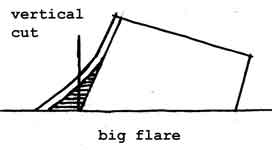 |
 |
If the ground is soft, you can rasp a lot of the flare while the hoof is on the ground; this saves the horse some painful time standing on the other foot. If you offer a soft place, the horse may lie down so you can work on the feet freely. With nippers, you can get most of the work done in a few minutes.
For a strongly slipper-toed founder, back the toe with a vertical, or even an under-cut angle, to leave plenty of wall protection in the upper part of the foot.
Backing-up the flare makes the horse immediately more comfortable, so that he can move around and get circulation to his feet. It also makes it easier for him to stand on that foot and pick up his other feet for you to trim.
2) HEELS
When the horse is able to hold up a foot for you (this may not happen on the first trim), scrape off chalky or flaky sole in the back half of the foot, so that you can see how far you can shorten the heel. In the toe area, leave the flaky sole for protection because the coffin bone may be penetrating the sole.
Shorten the heel by removing a wedge that begins a thumb-width behind the point-of-frog, and gets thicker toward the heels. Shorten heels only to the hard sole in the seat-of-corn; trimming into the sole will make the horse sore. If the horse can't hold up its feet long enough, leave the heels till another day.
The wedge-cut heel lets the toe tip off the ground. This reduces pain from pressure of the coffin bone on the sole corium.
Trim the back end of the bars enough that they don't touch the ground.
Then wait about 2 weeks and continue with the trim shown on the Do Trim page.
Hind feet are important to the foundered horse! He is carrying most of his weight on them, in an extremely collected position, to relieve pain in the front feet.
The heels wear down very fast, and the toes go "long out in front." This sets all the hind leg joints in an incorrect and inefficient position. The "stay apparatus" (an arrangement of the bones and tendons which allows the horse to sleep standing up) doesn't work in this position, so the hindquarters never get to rest. You will see the muscles on the rump quivering with exhaustion. It can be hard to keep weight on the horse while this is happening.
Therefore, keep the toes strongly backed up on the hind feet, so that he can stand with vertical cannons if he wants to.
Care of the Foundered Horse
All advocates of the barefoot method for founder agree: In rehabilitating a foundered horse, movement is essential. It's more important than having the trim exactly right -- though of course he will move best with the most comfortable trim.
The horse should have 24-hour turnout and 24-hour grass hay; no grain and no grass. If he won't move around on his own he can be hand-walked, as slowly as he needs to go, several times a day -- but if he's not moving, you probably haven't backed up the flare enough at the bottom of the wall. Backing up forward flared toe wall dramatically improves a horse's willingness to walk.
Movement circulates blood inside the hoof, bringing nutrition to the tissues for healing. If he can have another equine(s) for company, it will help him move around and keep him from getting depressed. Put his hay and water as far apart as possible, to encourage movement.
It's fine for a foundered horse to lie down a lot to rest his feet.
Farrier Gene Ovnicek and others are using styrofoam pads to make the horse's feet more comfortable. The pads are available, with a short video showing how to use them correctly, at www.hopeforsoundness.com, phone 719-372-7463.
You can make your own pads. Get one square of the 1/2 inch thick high density foam that is used when people have to stand on concrete all day at work. Cut to match the outline of the foot, and tape on with plenty of duct tape. (Mouse pad foam is too soft and will not protect the foot.) The horse can wear these for several days; he will be able to move around better, and healing will be much faster.
There is a soft protective boot for foundered horses, the SabreSneaker, available from 203-322-9002 or www.sabresneaker.com. Possibly has gone out of business? 10-1-2010
The Old Mac boot also works well for foundered horses: www.oldmacs.com.au
Here in the northeastern U.S., where the ground freezes hard and lumpy, the owner of a foundered horse made a pathway of stall mats to walk him during the dead of winter.
When walking a foundered horse, it's important not to lunge or circle him, and to let him take corners as slowly as he needs to. Reason: there is not much connection between the coffin bone and the hoof wall. If you ask for too fast a change of direction, the white line can tear loose again and set back the healing by a month or more.
The footing you walk your horse on is important. It needs to be hard enough to give the feet some concussion, for circulation, and should be as smooth and level as possible. Deep sand, bedding, and soft arenas don't provide circulation and the feet will get congested, increasing the horse's pain. If firm ground is not available, you are better off walking him on pavement with hoof boots or pads.
The conventional drugs given to horses with laminitis are often contradictory in their effects, and therefore confusing to the horse's system; they should be stopped. Painkillers can be used if he refuses to eat, drink, or move around on his own, then taper off over several days. Homeopathic remedies or herbs can also help with pain.
Feed should be grass hay (no alfalfa) available 24 hours. To provide a variety of vitamins and minerals, offer turnips, rutabagas, kale, collards, mustard greens, carrot tops; and local weeds and tree leaves that the horse likes.
To help the immune system, stop blanketing. Unlike the horse's own hair coat, a blanket cannot adjust its thickness to temperature fluctations; so the horse can get chilled or overheated, both of which over-stress the immune system. A clipped horse can grow enough coat in a few days; remember he's not in a stall now, he has room to move around when he gets cold.
Foundered horses sometimes stand in cold water for long periods to relieve heat and pain. You can offer a free-choice water- or mud-hole, or soak the feet in cold water with a little cider vinegar added.
For horses with laminitis caused by Cushings or insulin resistance, take a look atwww.ruralheritage.com/vet_clinic/epsmdiet1.htm
groups.yahoo.com/group/EquineCushings
Horses with laminitis often need extra magnesium. A highly bio-available form of magnesium for horses is sold as a supplement called Quiessence which is fairly expensive. You can get 50 pounds of Magnesium oxide at many feed stores, very inexpensive and the bag will last you for about a year.
The Chinese herb Jiao Gu Lan, 1/4 teaspoon of powder twice daily, can help the foundered IR horse. It helps the insulin uptake in the laminae. I give it to my two IR horses daily. I get it from AmeriHerb, Inc., phone 800-267-6141. Jiao (rhymes with meow) goo lahn. The tea form is very expensive.
Abscesses
When a horse has foundered, there is sometimes dead tissue inside the foot which his body has to remove in whatever way it can. Most of it will be handled by the liver, and some will be removed by a process of abscessing. Do not be alarmed by abscessing in a foundered horse. It is usually not an infection and doesn't need antibiotics.
Cider vinegar is good for soaking abscesses as it is slightly acid (epsom salts is too alkaline) and is a mild antibacterial. Put a cup in half-a-bucket of water, 20 minutes daily for several days.
Pete Ramey soaks in half cider vinegar / half water for 4 hours, once only. The stronger dilution may irritate the skin, but he reports it clears up an abscess quickly. This is a choice you have to make yourself.
Vicki Kline reports good results using "Animalintex" boric acid poultice pads for pulling out abscesses. It is available in sheets or pre-cut into hoof shape. You can cut a smaller piece for an abscess at the coronet. Available at tack / feed stores and veterinary supply catalogs.
Going back to work
As the foot begins to heal, you will see the hoof wall growing down from the hairline, at a new angle to the ground. This new wall is firmly attached to the upper part of the coffin bone by a strong laminar connection. As the new wall gets closer to the ground, the coffin bone becomes better suspended, and finally the sole will become concave.
When the horse has been on this program about 6 months, and is walking without pain, you can begin a few minutes of daily riding, at the walk, with hoof boots. Ride on firm (not over-soft) ground. Avoid doing circles and corners. Increase the distance as the horse is able. Don't ask for a trot; let him offer it on his good days -- it may take several months before his feet feel good enough to trot, carrying your weight. Likewise, he will eventually offer a canter when his feet feel good enough.
The horse won't be able to walk comfortably on gravel until the white line has completely healed and the coffin bone is well-attached inside the new hoof capsule. This can take a year; or much longer if the turnout situation is limited, preventing 24-hour free movement. As long as the white line is stretchy, the coffin bone rests directly on the sole corium, which will stay inflamed and will be painful on gravel, rocks, frozen ground, and/or pavement. Hoof boots are important if you have no place to walk or ride your horse on medium-firm ground (see Transition page for hoof boots).
There are many people who have successfully brought their foundered horses back to soundness, or who are currently in the middle of the process, who can be supportive of your program. It is helpful to have someone come show you how to do a wild-horse trim. See "Natural Horse Resources -- Hoof Care Providers" on www.tribeequus.com and "Trimmers List" and "Friends List" on www.TheHorsesHoof.com
